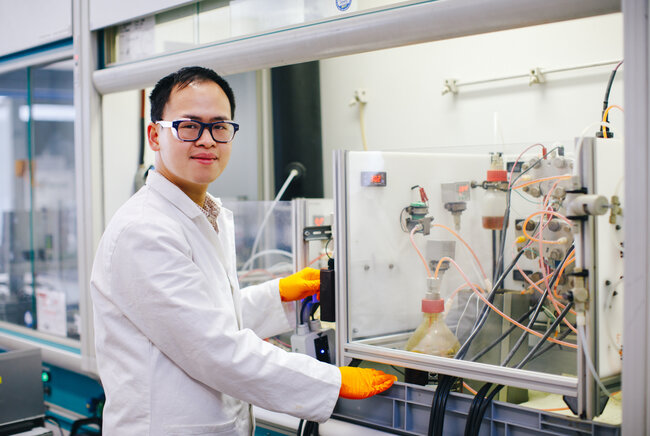Membrane development for hydrogen-bromine flow batteries
Finding a membrane-electrode with optimum resistance and durability.

Yohanes Antonius Hugo, PhD candidate at the TU/e Department of Chemical Engineering and Chemistry, researched new membrane options for hydrogen-bromine flow batteries (HBFBs), a promising electrochemical energy storage technology. He defended his thesis on November 13th.
To make the step to a future green system based on sustainable energy sources, the number of electrochemical energy storage technologies needs to grow fast. The hydrogen-bromine flow battery (HBFB) is one of the most promising flow batteries for low-cost, large-scale energy storage that offers a high degree of flexibility. In a time of surplus electricity, the HBFB stores electricity by oxidizing HBr into Br2 and H2. When electricity is required, the reverse reactions occur to discharge the electricity from the HBFB system.
The membrane-electrode assembly (MEA) plays an important role in the reversible electrochemical reactions, determining the HBFB performance and lifetime. The MEA forms the heart of the HBFB, and consists of a cation exchange membrane, a catalyst layer, and porous carbon electrodes. A balance needs to be struck in the MEA: a lower resistance improves HBFB performance while a better separation between the liquid electrolyte of the cathode on one side and the gaseous hydrogen of the anode on the other side improves the lifetime of the HBFB. In his PhD research, Yohanes Antonius Hugo studied several MEA design options to find the best performance and lifetime.
Building a better MEA, step by step
In an initial performance mapping study of commercially available membranes, Hugo found that perfluorosulfonic acid (PFSA)-type membranes are the most promising for HBFBs. They allow protons through in a higher rate than other membrane types. However, there are some drawbacks. The first one is the relatively high bromine species crossover that can degrade the catalyst particles and reduce the HBFB’s lifetime. Second, this type of membranes is prone to contaminants like positively charged ions and ionic liquid.
Therefore, Hugo developed novel composite membranes, spun from PFSA/polyvinylidene fluoride (PVDF). These membranes combine the benefits in the performance of both materials: a high proton conductivity with reinforcement that reduces PFSA swelling and limits bromine species crossover.
With these results, Hugo takes the field of HBFB research one step closer to finding an MEA with optimum resistance and durability.
Title of PhD thesis: Membrane development for large-scale hydrogen-bromine flow batteries. Supervisors: prof.dr.ir. D.C. Nijmeijer & dr.ing. Z. Borneman